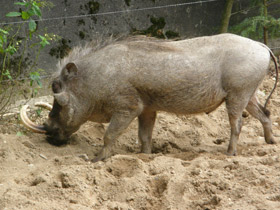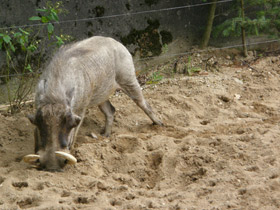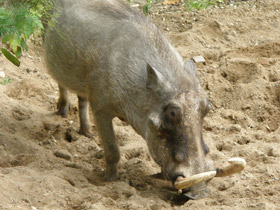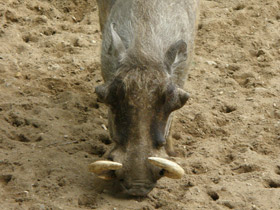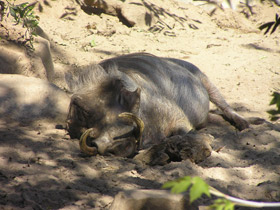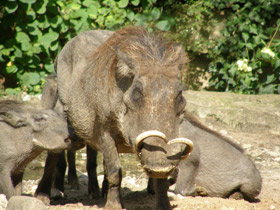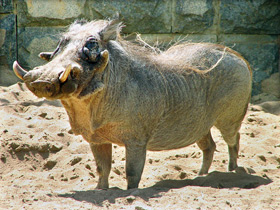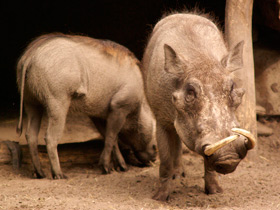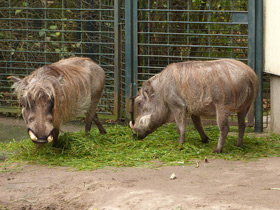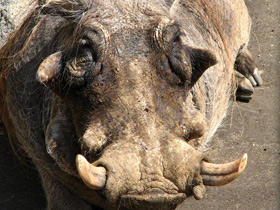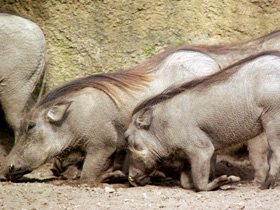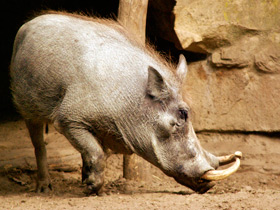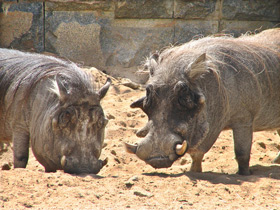Common warthog Phacochoerus africanus
Family Suidae – the pigs or suids
Representatives of this family are most ancient of all ungulates. They have four toes covered with hooves on each foot, with two central toes being larger than the others and serving for supporting the weight of these animals (two outer toes are located higher and not used when animals walk). The pigs have long pointed head ending with a flat cartilaginous disc with open nostrils. The pig can push various objects with this disc and uses it to dig into the ground. All pigs have a bristly coat. These even-toed ungulates have rather simple stomach, with two chambers, and large, hooked, curved tusks that grow out and backward. The Suidae family includes 8 extant species belonging to 5 genera.
The desert warthog Phacochoerus aethiopicus
At first sight, this animal may seem forbidding since its snout is covered with many protrusions presented by paired dense facial tissues looking like warts, and the “warts” are growing as the animal grows older; old males’ faces are all covered with large “warts”. A crest of fairly long sparse hair runs along the spine of this “monster”, from the neck to the base of the tail; the eyes with thick eyelashes are surrounded with bristly hair, and similar hair forms mutton chops on the lower jaw – the picture becomes complete with the sight of huge curved tusks reaching 30 cm (longest recorded tusks were 67 cm long!). The desert warthogs differ from the African warthogs in appearance: they are smaller in size and do not have functional incisors. The desert warthogs range in Ethiopia, Kenya, and Somali, where they inhabit open arid areas. While foraging, the warthogs bent their front legs and easily walk on their padded knees. Moving in this position, the warthogs dig deep furrow using their tusks rather than nasal disc. With the help of their snout and tusks, the warthogs dig for bulbs or roots and pull them out of the ground. They also eat caterpillars, pupae, bugs, worms, reptiles, and even carrion. Desert warthogs are mainly diurnal, resting in the bushes and under trees in the noonday heat; during the nights they hide in the crevices, abandoned termitaries, but can sometimes dig their own burrows.
The warthogs usually live in family groups consisting of related females and their young offspring. Their reproductive rate is very high: the female may give birth to one or two litters per year, each litter consisting of 2 to 7 piglets, and the mother nurses them only for three or four months. During first days after birth the piglets stay in the burrow, while the mother leaves her offspring and comes back only to feed them and warm them up in the night. Young warthogs emerge from the burrow at one week of age, and follow the mother in her long walks in the savannah. Young females reach maturity as early as at 9 months of age, and young males, at 18 months.
The common warthog (Phacochoerus africanus) is widely distributed in sub-Saharan Africa, occurring in moist and dry African savanna grasslands, open bushlands and woodlands. This animal is very similar to the desert warthog in appearance and lifestyle.


















